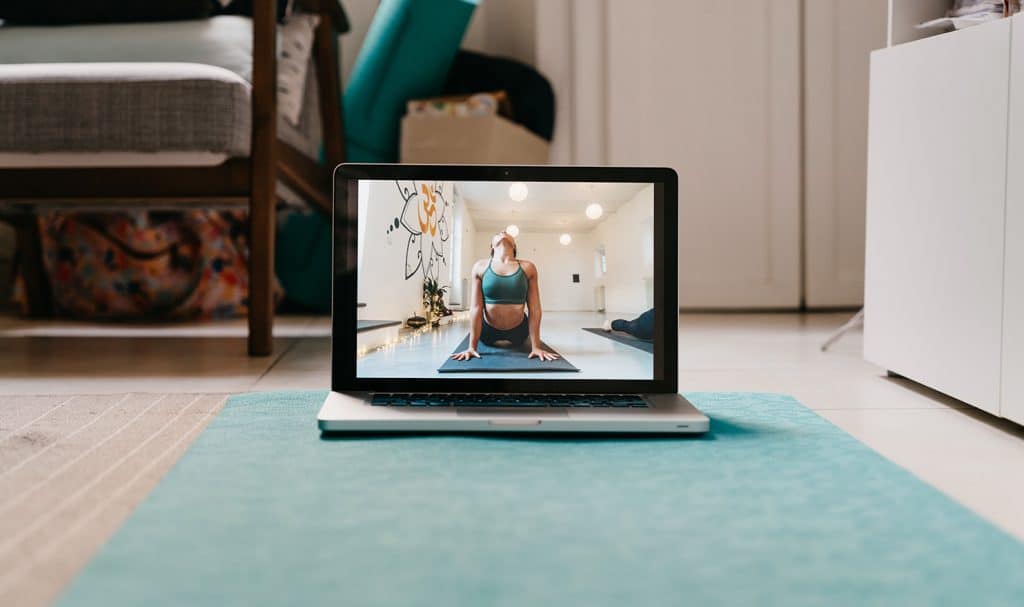From P90X and Peletons to Jane Fonda and Richard Simmons on VHS, at-home workouts have been shaping the fitness industry for decades. While COVID-19 may have brought a recent increased interest in virtual personal trainers, the concept of home fitness is nothing new.
Today, personal trainers aren’t limited to in-person sessions at the gym or in a client’s home. Online personal training can now accommodate the busy schedules of both trainers and clients. But, how do you start an online fitness business?
Whether you are looking to try some online personal trainer sessions, or fully make the switch, it’s a good idea to know how to become a virtual personal trainer and what to expect. To help you along the way, Insurance Canopy has gathered our top tips for becoming an online personal trainer.

What To Know Before You Start
An online personal trainer takes on a lot of responsibilities outside of just training clients—which can take up more time than some people realize. In fact, the average small business owner spends 68.1% of their time working “in” their business on the day-to-day tasks. Some of the things you need to be aware of include:
- Marketing and advertising
- Social media management
- Finance and accounting
- Data management and software
- Video and content creation
- Communication and client outreach
While you may be able to manage some of these tasks on your own, we understand your main focus is going to be on training clients. As your business grows, it may not be possible to balance all these business needs on your own. It’s okay to ask for help when managing your business—you are not expected to do it all alone!
In this nine-part series, we will explore the details of how to set up online personal training to help you know what to expect. Each part will touch on many of the different business activities listed above and how you can manage them as an online personal trainer.
Today let’s look at 3 tips for creating your virtual training space.
Just last year, 5,498 personal trainers protected their businesses for as low as $12.50 a month. Get your FREE personal trainer insurance quote today!

Tip #1: Find Your Virtual Training Space
How do you want to train your clients? First you need to decide if you want to offer live virtual training sessions, pre-recorded training programs, or a hybrid of both.
Live Online Sessions
If you prefer to train a client one-on-one, or lead a group of clients all at once, live online sessions allow you to maintain the trainer-to-client relationship with daily or weekly calls. Live training sessions eliminate the need to work at a busy gym, commute to locations, or pay for a private studio—without having to sacrifice face-to-face interaction.
Zoom and Skype are two wonderful ways to virtually connect with your clients. You can try a free or paid version, and still be able to train your clients in real time. If you’re unsure of how you feel about teaching virtually, you can test it out by hosting a live class on social media.
Pre-Recorded Training Programs
Sometimes your clients have a busy schedule and don’t have the ability to consistently set aside time to train with you. Online training courses can be the answer. This allows clients to workout at a time convenient to them and allows you to have more freedom in your schedule.
We suggest keeping your content private and allowing clients to access it by purchasing individual programs or signing up for a paid subscription. This can keep it from being stolen or copyrighted and help you grow your business. You can upload videos to your own website, keep private training plans in downloadable documents, house your videos on a private YouTube channel, or purchase software where you can upload and offer your online courses.
Combining Live Trainings With Pre-Recorded Programs
The great thing about being a virtual personal trainer is you can make your own training format. By combining both techniques, you have the ability to train some clients in real-time while others can do a program on their own time. You can even keep some in-person clients if you’d like! Find a system that works best for you and the type of clients you want to work with.

Tip #2: Creating Your Virtual Training Room Setup
Once you know how you are going to train your clients, you can begin to prepare the space to do it. Start by finding a location to conduct your online training. You want it to look professional, but it doesn’t have to be a fancy production set. Use your home gym or convert part of your garage into a workout space. You can even talk with your local gym to see if they would let you film videos in their aerobics room when it’s not in use.
Make sure your location is well-lit, has good sound quality, and is free of distractions. While training outside might be nice, things like wind, bad weather, and your neighbor’s barking dog can affect the quality of your video. If you are training live, you want to make sure you have a strong wifi connection so your session isn’t plagued with frozen video, broken audio, or dropped calls.
Wherever you choose to conduct your virtual training, be sure to have the proper equipment on hand for the workouts you plan to teach. You can keep things like weights, kettlebells, and jump ropes off camera until you need them, but show any equipment you will be using at the start of your training session so a client is prepared.

Tip #3: Coordinating With Clients
Just like training in-person, training online can come with it’s own challenges. Life happens—you can get sick or need time off, a client may forget about a scheduled Zoom training, or your website crashes and clients can’t load the programs they bought. Having a back-up plan and keeping open communication with clients can help smooth out some of these bumps you encounter.
As a personal trainer, your health comes first. You can’t expect to train clients if you are sick or injured. Sometimes you need a break to focus on your mental health. Whatever comes up, be prepared to keep your clients on track. If you do live training sessions, have pre-recorded sessions on hand you can send out. If you are unable to film all of your online training courses, have another trainer stand in for you and try narrating the video so clients still hear your voice guiding them.
To keep clients from missing their live sessions, you can send them text messages and email reminders with a link to join the call. Be sure to include the time and date of the session in your reminders. You can notify clients a week in advance, a few days before, or even in the hours leading up to the session. To make sure you still get paid, you can charge clients up front for a certain amount of set sessions or have a missed session fee. Still be flexible and allow clients to plan ahead for missed sessions or let them reschedule in the case of an emergency.

“How To Become An Online Personal Trainer” is a nine-part series by Insurance Canopy outlining tips and tricks to help you take your training to the next level. Check out the rest of the series below!
Part Two: Creating Scalability
Part Three: Building Your Exercise Library
Part Four: Creating Online Fitness Training Packages
Part Five: Transitioning Clients To Virtual Training
Part Six: Gaining New Clients
Part Seven: Data Documentation & Client Organization
Part Eight: Protecting Your Business
Part Nine: 5 Additional Tips For Continued Success


